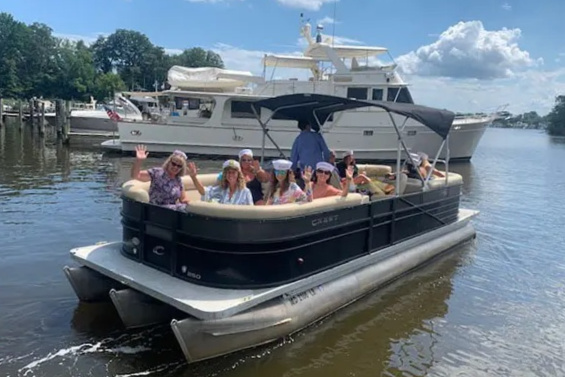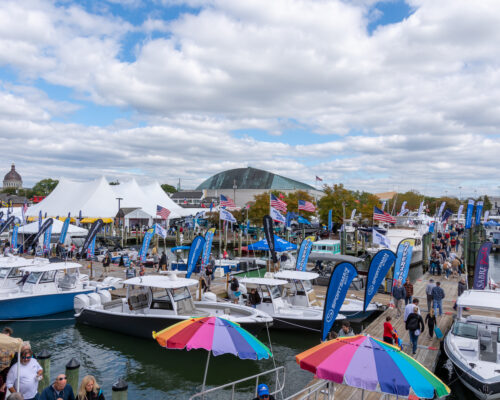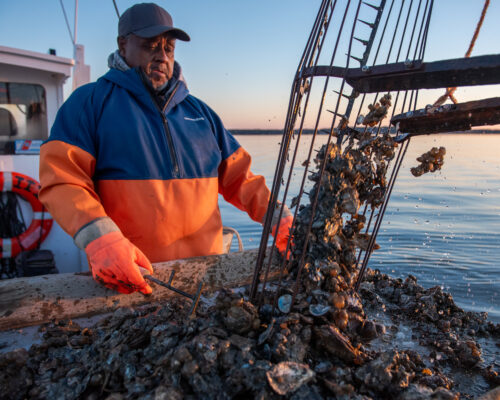It’s the ultimate party boat, built for comfort and nicknamed the “Living Room on the Lake.” Some longtime Bay boaters turn up their noses at the thought of tooling around their river in a pontoon boat, but today’s modern pontoons just might make sense for some kinds of Bay boating. Pontoon-curious? Read on.
It appears that the concept of using two floating hollow tubes to support a flat deck harkens way back to China during the Zhou Dynasty, when such contraptions were first linked together to build bridges so armies could cross rivers. Then 3,000 years later, in 1952, a Minnesota farmer named Ambrose Weeres bolted a plywood deck onto a pair of empty oil drums. History has not recorded whether Mr. Weeres was inspired by Emperor Zhou, or whether he was just an inventive guy with empty oil drums lying around the barn and an urge to go fishing. History did record that he was the one who created a whole new genre of vessels that we now call “pontoon boats.”
More than 70 years later, pontoon boats have come a long way. There are about 30 manufacturers in the U.S. alone, mostly based in the Midwest, that build and sell them in a wide variety of shapes and sizes. Over the past few decades, there have been evolutions in the design, construction and performance capabilities that have made this type of boat one of the more popular for entertaining, fishing and certain water sports.
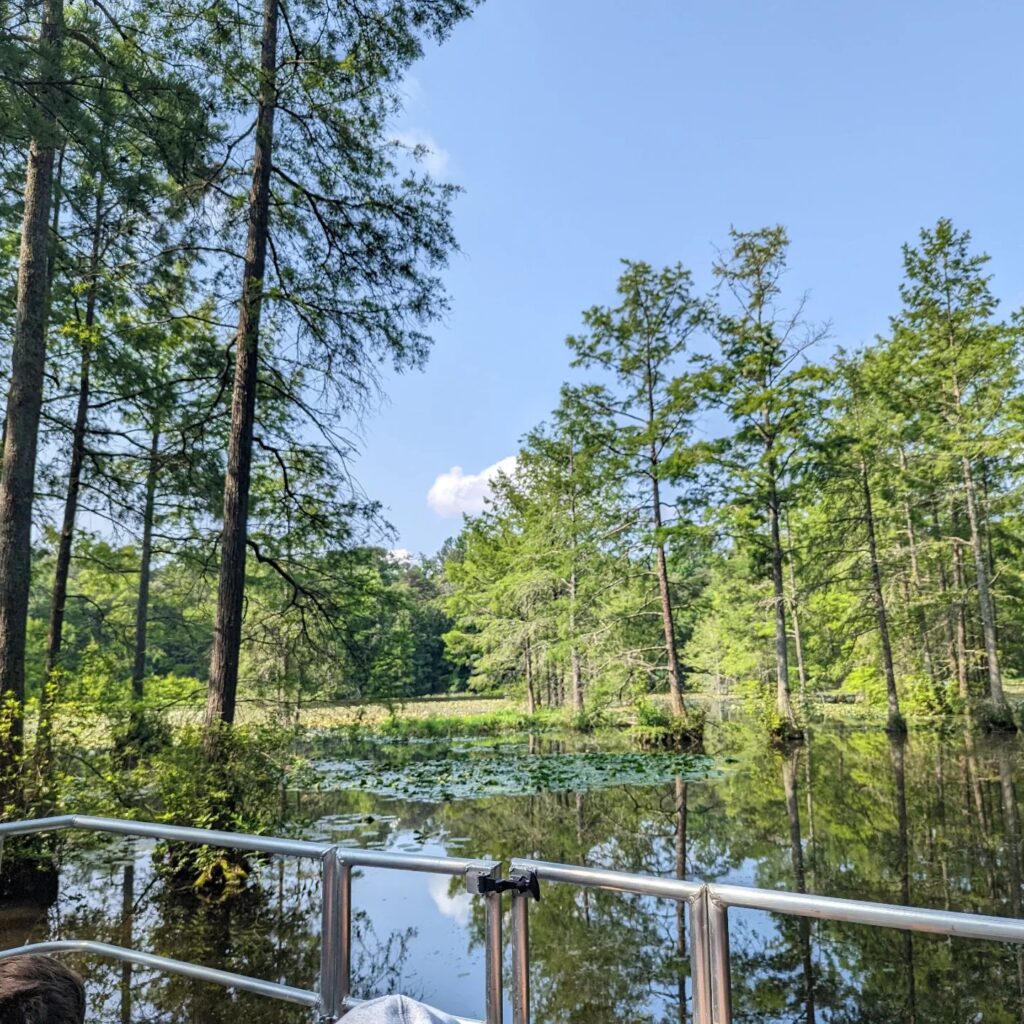
One of the leading manufacturers, Godfrey Marine, based in Elkhart, Indiana, currently builds no fewer than 27 different models, ranging from the 15-foot Mighty G, powered by a 50hp outboard and costing $23,615, to the luxurious XP 28’ that can be powered by twin 400hp outboards at a price of $231,600. This brand is so popular, you can even order one through your local Sam’s Club.
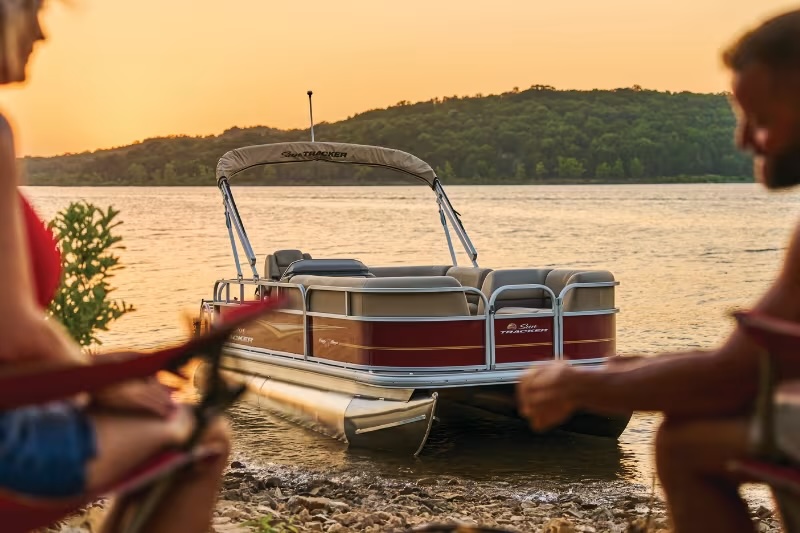
Sun Tracker Boats, built in Springfield, Missouri, offers an 18-foot “Party Barge DLX” powered by a 50hp Mercury four stroke outboard for just $16,995 (not including the trailer). It’s available through Bass Pro Shops.
Depending on the options your order, you can spend up to $299,995 on Bennington’s ultra- premium 25 QX Sport, a 25-foot pontoon designed for maximum performance on the water. It features an integrated, custom-built Roswell wake tower and a rakish windshield. The foredeck is spacious and elegant, and there’s a unique bow gate design and integrated docking lights.
Luxury details include a top-of-the-line sound system controlled by two touch screens mounted at the helm. There’s a commercial-grade built-in refrigerator and to top it off, there’s even a kitchen sink tucked discreetly in the console.
Even Sea-Doo now has a line of pontoon boats that are beginner-friendly, accomodate up to 10 people, and come with a trailer included. They’re available at boat and motorsport dealers alike.
The word “pontoon” likely comes from the Latin word pontinum, which means “flat-bottomed boat,” but that doesn’t accurately describe the breed. Pontoon boats have a flat rectangular deck that rests on hollow aluminum tubes. Most models have two tubes, but some have three.

Three-pontoons boats, or “tritoons,” are designed with the center tube lower in the water, allowing them to bank into turns more like a V-hulled boat. The third tube in the center distributes weight more evenly over the water, providing additional stability and structure that means the boat can handle more horsepower than a typical twin-tube pontoon boat. So three- tube pontoons allow for a wider range of activities, a more stable ride and a little more speed than a traditional two-tube pontoon.
No matter how many tubes make up its hull, the pontoon boat offers a variety of advantages over other boats. They provide a wide, stable platform with enough room for the whole family.
The high railings and gates provide extra security for those boating with younger children. Pretty much anyone of legal age and ability can handle them safely. Plus, pontoon boats feature wide gates and open floor plans, providing easy access and space for those with mobility issues.
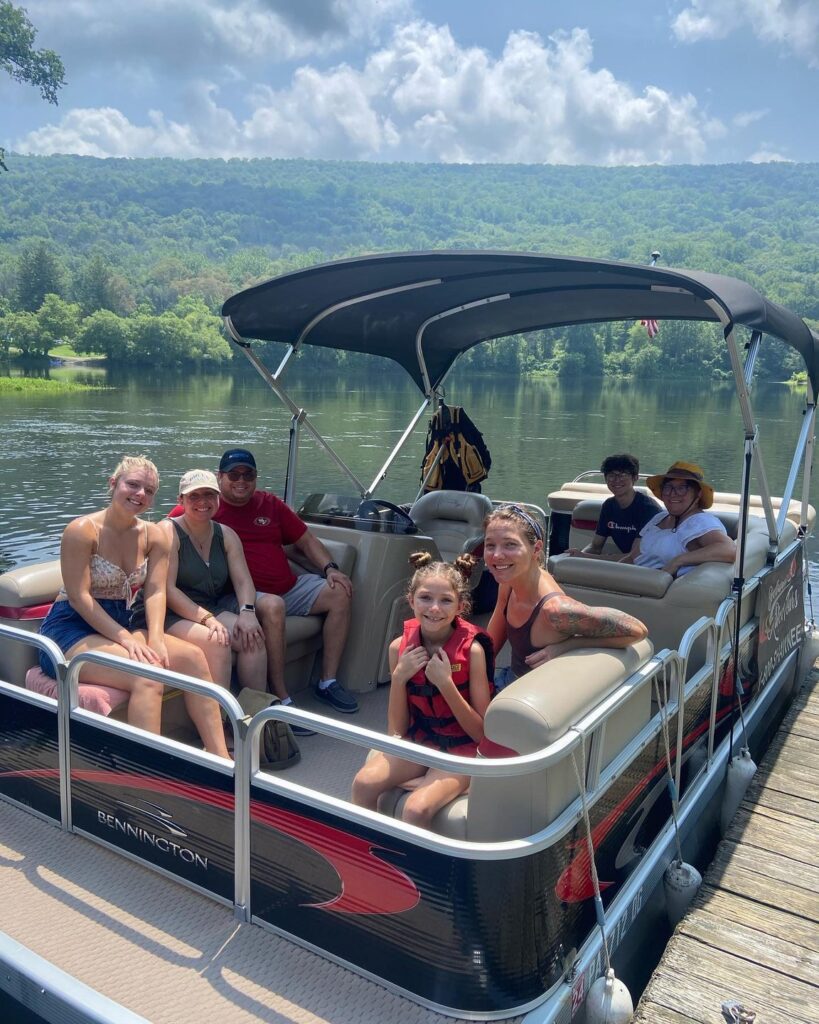
Pontoon boats are also easy and relatively inexpensive to maintain. One industry analyst claims that people own their pontoon boats 20–25 percent longer than other boats and they tend to have a higher resale value when owners do sell them.
While pontoon boats offer an incredibly stable ride in calm seas, they can be hazardous in severe storms. A big wave hitting the front of a pontoon boat can make the bow dive into the wave instead of riding over the top. In extreme circumstances, this can cause capsizing. So can high gusts of wind. Five tourists died in 2004 when a fast-moving cold front packing 50-mile-an-hour winds capsized a pontoon water taxi that was ferrying them around Baltimore’s historic Inner Harbor.
Despite that risk, pontoon boats are popular, not just in the lake country of the American Midwest, but also in coastal areas like the Chesapeake Bay because they can be used for so many different activities: watersports, swimming, day cruising, sunset cocktail crawls, or just messing about. There are pontoon boats designed for fishing, performance pontoons with high- powered outboard motors, and luxurious pontoons equipped with everything from a margarita blender to an enclosed head. One design even has a raised sun deck, almost like a tuna tower on a sportfisherman.
When shopping for a new or used pontoon boat, here are some key questions you should ask yourself in order to focus your search:
• What’s your primary use for the boat? Fishing? Day cruising? Entertaining at the dock?
• Where do you plan to use it and when?
• Does your vehicle have the capacity to tow it?
• What’s the maximum number of people you’re going to host on it at any given time?
• What is your budget? Not just for purchasing the boat, but also for fuel and dockage,
insurance, maintenance and storage.
• Most pontoon boats can be stowed on a trailer, but you might have your own pier,
preferably with a boat lift. Boatels might be an option as well. Winter storage might be an
issue if you don’t want it taking up space in your driveway.
Pontoon boats aren’t for everybody, nor are they meant to handle all weather conditions. One way to discover whether they’re right for you and your family is to rent different models in different locations, then start booking test drives with local dealerships. On a calm day, moving the family room onto the water might be just the thing.

